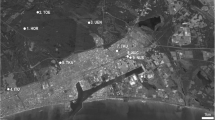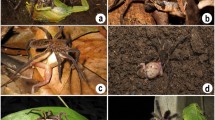Abstract
Declines in amphibian populations and the loss of some species has spurred research into the causes of declines. Little research has been done on what the loss of amphibian species may mean to ecosystem function. I describe a field experiment where the number of Plethodon cinereus (the red-backed salamander) was manipulated in enclosures buried in the forest floor. I determined the composition of the forest floor invertebrate community and the rate of decomposition of leaf litter in enclosures with and without salamanders over 4.5 months. Salamander predation in enclosures significantly reduced invertebrate numbers compared to control enclosures. Salamander predation also indirectly reduced rate of decomposition by between 11 and 17%. This was probably due to salamanders consuming a significant number of leaf fragmenters (e.g. Coleoptera and Diptera larvae). Predation on leaf litter fragmenters may alter carbon dynamics in forested ecosystems.
Similar content being viewed by others
References
Beyers, R.J. and Odum, H.T. (1993) Ecological Microcosms. New York: Springer-Verlag.
Blair, J.M., Parmelee, R.W. and Wyman, R.L. (1994) A comparison of the forest floor invertebrate communities of four forest types in the northeastern U.S. Pedobiologia 38, 146–60.
Blaustein, A.R., Hoffman, P.D., Kiesecker, J.M. and Hays, J.B. (1996) DNA repair activity and resistance to solar UV-B radiation in eggs of the red-legged frog. Cons. Biol. 10, 1398–02.
Burton, T.M. and Likens, G.E. (1975a) Energy flow and nutrient cycling in salamander populations in the Hubbard Brook Experimental Forest, New Hampshire. Ecology 56, 1068–80.
Burton, T.M. and Likens, G.E. (1975b) Salamander populations and biomass in the Hubbard Brook Experimental Forest, New Hampshire. Copeia 1975, 541–46.
Ciais, P., Tans, P.P., Trolier, M., White, J.W.C. and Francey, R.J. (1995) A large northern hemisphere terrestrial CO2 sink indicated by the 13C/12C ratio of atmospheric CO2 Science 269, 1098–02.
Conant, R. (1992) A Field Guide to Reptiles and Amphibians. Boston: Houghton and Mifflin Co.
Drost, C.A. and Fellers, G.M. (1996) Collapse of a regional frog fauna in the Yosemite Area of the California Sierra Nevada, USA. Cons. Biol. 10, 414–25.
Elliott, W.M., Elliott, N.B. and Wyman, R.L. (1993) Relative effects of leaf litter and forest type on rate of decomposition. Am. Midl. Natur. 129, 87–5.
Fisher, R.N. and Shaffer, H.B. (1996) The decline of amphibians in California’s Great Central Valley. Cons. Biol. 10, 406–13.
Frisbie, M.P. and Wyman, R.L. (1992) The effect of soil chemistry on sodium balance in the red-backed salamander: a comparison of two forest types. J. Herpetol. 26, 434–42.
Frisbie, M.P. and Wyman, R.L. (1995) A field simulation of the effect of acidic rain on ion balance in a woodland salamander. Arch. Environ. Contam. Toxicol. 28, 327–33.
Gifford, R.M. (1994) The global carbon cycle: a viewpoint on the missing sink. Aust. J. Plant Physiol. 21, 1–15.
Hairston, N.G., Sr (1987) Community Ecology and Salamander Guilds. New York: Cambridge University Press.
Heatwole, H. (1962) Environmental factors influencing local distribution and activity of the salamander, Plethodon cinereus. Ecology 43, 460–72.
Hecnar, S.J. and Mc'Cluskey, R.T. (1996) Regional dynamics and the status of amphibians. Ecology 77, 2091–97.
Huston, M.A. (1993) Biological Diversity: the Coexistence of Species on Changing Landscapes. New York: Cambridge University Press.
Jaeger, R.G. (1980) Microhabitats of a terrestrial forest salamander. Copeia 1980: 205–8.
Jaeger, R.G., Joseph, R.G. and D.E. Barnard (1981) Foraging tactics of a terrestrial salamander: sustained yield in territories. Anim. Behav. 29, 1100–05.
Jones, C.G. and Lawton, J.H. (1995) Linking Species and Ecosystems. New York: Chapman and Hall.
Kicklighter, B.W., Melillo, J.M., Peterjohn, W.T., Rastetter, E.B., McGuire, A.D. and Steudle, P.A. (1994) Aspects of spatial and temporal aggregation in estimating regional carbon dioxide fluxes from temperate forest soils. J. Geophysical Res. 99, 1303–15.
Laurence, W.F., McDonald, K.R. and Speare, R. (1996) Epidemic disease and the catastrophic decline of Australian rain forest frogs. Cons. Biol. 10, 406–13.
Lawton, J.H. and Brown, V.K. (1994) Redundancy and ecosystems. In: Biodiversity and Ecosystem Function (E.-D. Schulze and H.A. Mooney, eds) pp. 255–70. Berlin: Springer-Verlag.
Pimm, S.L., Russell, G.J., Gittleman, J.L. and Brooks, T.M. (1995) The future of biodiversity. Science 269, 347–50.
Pounds, J.A. and Crump, M.L. (1994) Amphibian declines and climate disturbance: the case of the golden toad and the harlequin frog. Cons. Biol. 8, 72–85.
Schulze, E.-D. and Mooney, H. (1993) Biodiversity and Ecosystem Function. Berlin: Springer-Verlag.
Sokal, R.R. and Rohlf, F.J. (1981) Biometry. New York: W.H. Freeman.
Wake, D.B. (1991) Declining amphibian populations. Science 253, 860.
Wilson, E.O. (ed.) (1988) Biodiversity. Washington, DC: National Academy Press.
Wyman, R.L. (1988) Soil acidity and moisture and the distribution of amphibians in five forests of southcentral New York. Copeia 1988, 394–99.
Wyman, R.L. (1990) What’s happening to the amphibians? Cons. Biol. 4, 350–52.
Wyman R.L. and Hawksley-Lescault, D. (1987) Soil acidity affects distribution, behavior and physiology of the salamander Plethodon cinereus. Ecology 68, 1819–27.
Wyman, R.L. and Jancola, J. (1992) Degree and scale of terrestrial acidification and amphibian community structure. J. Herpetol. 26, 393–401.
Author information
Authors and Affiliations
Rights and permissions
About this article
Cite this article
Wyman, R.L. Experimental assessment of salamanders as predators of detrital food webs: effects on invertebrates, decomposition and the carbon cycle. Biodiversity and Conservation 7, 641–650 (1998). https://doi.org/10.1023/A:1008856402258
Issue Date:
DOI: https://doi.org/10.1023/A:1008856402258




